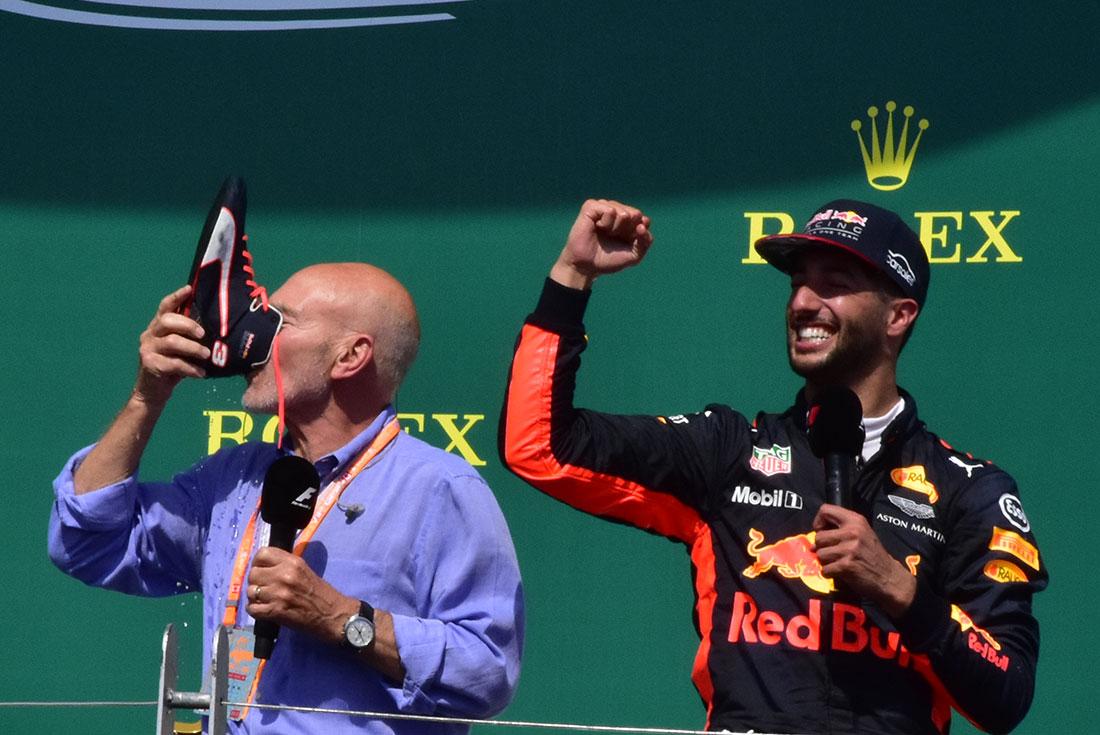A Brief History of Sneakers In Motorsport
The world of motorsport is just as, if not more, complex than the world of sneakers. When these worlds collide, it’s often a fantastic crash of high-performance technology and nitro-fuelled design. The trickle-down effect of developments in the motor industry into the sneakersphere has previously been documented , and some of the coolest kicks spotted on the racetrack can be seen . Now it’s time to learn about how footwear has been fine-tuned over the years for everyone from daily drivers to pro Formula One racers.

What Makes a Good Driving Shoe?
In 1963, Italian shoemaker Gianni Mostile patented the driving moccasin design. Its distinct knobbly outsole that wraps up to the rear is designed to protect the heel counter from the floor of the car while the foot is in the driving position. The lack of an external midsole also keeps feet closer to the pedals for better control. While the absence of laces prevents any prang-inducing tangles.
Today, driving moccasins may be a mainstay of the casual-lux and beach wedding crowd, but Mostile’s design was born out of necessity, and the low-profile sole and wrapped heel concept remain essential components of well-designed driving sneakers to this day.
Around the same time Mostile was organising his patent, chemical engineering company DuPont (who are known for inventions such as PTFE and neoprene) developed Nomex, a heat-resistant synthetic fibre that could be used for applications like fire fighting and electric circuit lining. A spate of fiery deaths on the racing circuit led to Nomex being specified for racing drivers’ uniforms, gloves and, of course, footwear by the end of the decade. These days, Nomex is still an essential material for serious drivers, and its use is often a requirement for products to meet driving safety regulations.
Contemporary Contenders
With the famous Nürburgring circuit as one of their test tracks, it’s no surprise have a strong motorsport pedigree. Their Monza racing boots were instrumental for champion F1 drivers like Mario Andretti in the late-70s, which built a strong heritage for casual models in the 2000s. The quilted Monaco GP boot and the Tuscany both featured rubber tread from tire manufacturer Goodyear. The motoring influence carries on today, with a long-standing rubber supply from tyre neighbours Continental.
Meanwhile, the adidas Feroza and Daytona driving boots are among the go-to choices for serious karters who have clocked some hot laps. Keeping with current regulations, these models feature the requisite Nomex lining to protect from flames, and use an ultra-thin sole for superior pedal feel.
best-known driving shoe, at least domestically in Japan, is the ARD-336 racing boot, which is sometimes called the ProGear MT. Similar to most serious high-octane high-tops, it features a durable suede upper, super slim rubber sole, and heel wrap. It’s particularly prominent because it was the shoe of choice for Tsuchiya Keiichi, aka the Drift King – who is perhaps best known in the West for his brief cameo in The Fast and The Furious: Tokyo Drift.
Rather conspicuously, have been absent from the motorsport sneaker game since 2003. Despite a famous partnership with Scuderia Ferrari’s Michael Schumacher in the mid- to late-90s, which even spawned a few signature shoes like the Air Zoom Schu, the Swoosh’s F1 foray ended abruptly around 2002 when began outfitting the Ferrari team. However, that was another short-lived race for the Prancing Horse, as took it from there and dominated the F1 circuit with Schumacher and co. shortly after in 2004.
PUMA Motorsport in Pole Position
Of the major brands, it seems PUMA are still in pole position when it comes to motorsport sneakers. Even before the aforementioned Schumacher partnership, the Leaping Cat were already making inroads in the late-90s with the Speed Cat, a slim-soled racing shoe that also had a street-ready low-cut edition.
The Speed Cat set a template for low-profile sneakers throughout the 2000s, and it spawned variants with related monikers like the Drift Cat. All have centred around the flat outsole and heel wrap. Other models like the Future Cat (a Schumacher favourite) proposed alternative design cues, such as off-centre lacing for increased circulation.
PUMA have recently released limited editions of the current Speedcat Pro – identical to the pairs worn by their F1 driving stars. They’re the real deal, featuring actual carbon fibre for heel lockdown, fire-resistant materials, and an ankle-hugging fit.
Today's Motorsport Shoes
The 2020 F1 season has been tumultuous to say the least, but a few shoeys have still been poured on the podium steps. At the highest ranks of the sport, industry-specific brands like Sparco and Alpinestars are neck-and-neck with PUMA. The next step for sneaker- and motor-heads is to see more crossovers onto the racetrack and tarmac!
For more historical dives, and broad sneaker knowledge, visit the Features section .
Note: The header image source was Wikimedia Commons and the user was ‘Kaiketsu’. The image has been cropped slightly, and the original can be seen
